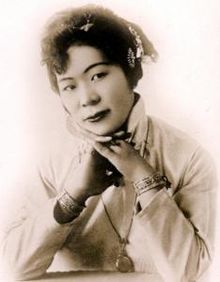Marion E. Wong
Marion E. Wong | |
|---|---|
 | |
| Born | January 2, 1895 San Francisco, California, U.S. |
| Died | February 4, 1969 Alameda, California, U.S. |
| Occupation(s) | Actress, producer, and director |
| Parent(s) | Jim Sing Wong, Chin See |
| Wong Neui Tai | |||||||||||||
|---|---|---|---|---|---|---|---|---|---|---|---|---|---|
| Chinese | 黃女娣 | ||||||||||||
| |||||||||||||
Marion E. Wong (January 2, 1895 – February 4, 1969) was a Chinese American company director, costume designer, director, actress, producer, music performer and screenwriter.[1]
Biography
Marion Evelyn Wong was born on January 2, 1895 in San Francisco[2] but was raised in Oakland, California. In 1911, Wong travelled to China to meet her future husband. Her two brothers, who were looking for wives, accompanied her. One of her brothers died in China due to smallpox. The other brother Albert Wong, married Violet, who was the sister-in-law to Marion. Wong returned home without a husband because she refused to marry him.[3] Wong was also a student at the University of California for some time where she took up special work.[4]
The Curse of Quon Guon
In 1916, at the age of 21, she established the Mandarin Film Company. Her uncle, Ben Lim, described in a 1916 newspaper article as a “wealthy Chinese merchant and landowner”, provided the funding.[3] Her trip to China also served as inspiration for The Curse of Quon Gwon: When the Far East Mingles with the West, Marion's first film in the Mandarin Film Company. The film was regarded as the first Chinese-American feature film.[5] The film was also written, produced, and directed by Wong, who also designed the costumes and sceneries. Marion also cast herself as one of the characters in the film. The Curse of Quon Gwon was the first and only film made by an all-Chinese cast and an all-Chinese company. An article in the July 17, 1917 issue of The Moving Picture World said that the film “deals with the curse of a Chinese god that follows his people because of the influence of western civilation.”[6] It is also about Chinese assimilation into American society.
In an Oakland Tribune article dated May 11, 1916, Wong said that she had never seen any Chinese movies.
|
''“…I decided to introduce them to the world. I first wrote the love story. Then I decided that people who are interested in my people and my country would like to see some of the customs and manners of China. So I added to the love drama many scenes depicting these things. I do hope it will be a success.”[7] |
Even with all of her efforts, The Curse of Quon Gwon only had two screenings after its completion. A rough cut of the film was viewed in 1916 at the Kinema Theater and a formal premier of the film was shown in 1917 but the film did not receive commercial distribution.[3] Seen as a financial failure, Wong asked her family to never speak of the film again. Her uncle Lim at this time also declared bankruptcy, for he did not see any possibility of return of his investment.[7] Wong’s company did not produce any other films after the flop of The Curse of Quon Gwon.
After the Mandarin Film Company
In 1917, Wong married Kim Seung Hong (Chinese: 熊錦湘).[2] He was the first Chinese student to graduate from the University of California – Berkeley and was the first Chinese electrical engineer in the country. After Kim and Wong got married, Wong founded the Singapor Hut restaurant in Richmond, California in 1919. The restaurant soon became popular for its musical cabarets. Wong performed everything from traditional Chinese operas to popular music at The Singapor Hut. During this time, Wong also toured in vaudeville as a singer and musician.[3] Wong died in 1969.
After Death
Despite not being interviewed about the film since 1917 or mentioning the film after the downfall of it, Wong’s film came into the spotlight when two reels were found in an Oakland basement. Only two reels of the eight-reel film survive, and they do not explain the characters or plot.[1] These reels are currently featured at the Oakland Museum of California.[8]
Since its last screening in 1917, Wong’s film was screened only twice over the following ninety years. It was shown once in 1948 at a public screening in Berkeley, California and once in 1974 at a screening for over seventy family members. The rediscovery of the film brought the film and Wong’s children together since Wong’s children were unaware of their mother’s accomplishment.[1]
Thirty-six years after Wong’s death, in 2006, The Curse of Quon Gwon was successfully added to the National Film Registry and cataloged with the Library of Congress.[5]
References
- ^ a b c WFP "Marion E. Wong". Women Film Pioneers Project. Retrieved 13 November 2014.
{{cite web}}: Check|url=value (help) - ^ a b Mark, Gregory. "The Curse of Quon Gwon: Chinese American's Pioneering Film" (PDF). lcds.gov.hk. Retrieved 8 December 2014.
- ^ a b c d Eagan, Daniel (2010). America's Film Legacy: The Authoritative Guide to the Landmark Movies in the National Film Registry. A&C Black. p. 55. ISBN 978-0826429773. Cite error: The named reference "America's Film Legacy" was defined multiple times with different content (see the help page).
- ^ Rubio, J. "Violet's Dining Room". El Cerrito Historical Society. Retrieved 8 December 2014.
- ^ a b "Films Added to National Film Registry for 2006". Library of Congress. Retrieved 8 December 2014.
- ^ "Moving Picture World". Lantern.mediahist.org. New York, Chalmers Publishing Company. Retrieved 8 December 2014.
- ^ a b ., Tart. "Badass Ladies of History: Marion E. Wong". Persephone Magazine. Retrieved 8 December 2014.
{{cite web}}:|last1=has numeric name (help) - ^ "Marion Wong". Local Wiki.
